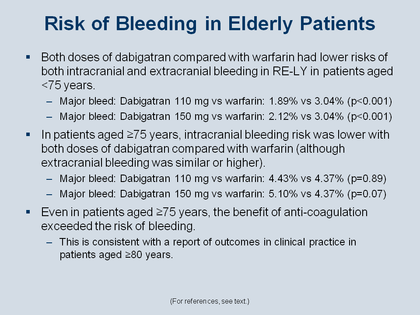James A. Reiffel, MD - Novel Oral Anticoagulants - Figure 24
Risk of Bleeding in Elderly Patients
As seen in the previous Figure, only the risk of GI bleeding was worse with dabigatran 150 mg, particularly in patients aged ≥75 years. However, as seen in this Figure, there was a lower risk of a major bleed, a life-threatening bleed, and of intracranial bleeds with either dose of dabigatran versus warfarin.[109] Although not shown in the Figure, there was a trend in overall mortality favoring dabigatran, but the hazard ratio was not significantly lower (p= 0.51). Thus for both doses of dabigatran compared to warfarin there was
- lower risk of intracranial and extracranial bleeding in patients aged <75 years
- a lower risk of intracranial bleeding in patients aged ≥75 years
and even in patients aged ≥75 years, the benefit of anticoagulation exceeded the risk of bleeding.
This raises an important question that physicians should ask themselves in addressing the issue of risk with their patients:
No one wants to bleed, and no one wants to have a stroke, but if it comes to making a choice, which would you prefer?
The answer from almost all people will be that the risk of bleeding is less to be feared than the risk of a stroke, which is much more likely to be debilitating or even fatal. And so most patients and physicians would see the risk of bleeding as less important – and that risk is even lower with the new anticoagulant drugs that offer the probability of better therapy than warfarin.[110]
Reiffel JA. Am J Med 2013; 126: 00-00.

